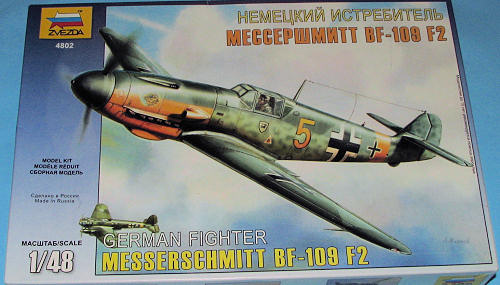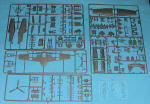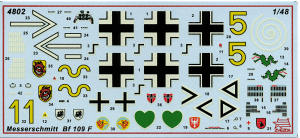
Zvezda 1/48 Bf-109F-2
| KIT #: | 4802 |
| PRICE: | $30.00 MSRP |
| DECALS: | Four Options |
| REVIEWER: | Scott Van Aken |
| NOTES: | New mold kit. |

| HISTORY |
Bf 109F-2 was introduced in March 1941, soon after F-1, first production version, reached units, still with old DB 601N engine, and new rapid firing MG151/15 15mm auto-cannon instead old MG/FF in the nose. Some pilots, like Galland, considered this weapon arrangement to light, especially for inexperienced fliers, so later F-4 got heavier MG151/20, still not heavy enough.
Friedrich was the principal fighter at the start of Russian campaign and many top aces started their scores with this fine plane.
| THE KIT |
 Zvezda
joins the ranks producing 1/48 Bf-109F versions that Started with Airfix. A
goodly amount of time followed until Hasegawa produced their still excellent
series, followed by Hobbycraft then ICM. ICM introduced a full engine and a
ton of fillers and inserts. Zvezda continues this trend, however, it seems
from the look of the parts, that this one may well fit a bit better than the
ICM version. If you recall how nice Zvezda's La-5 kits are, then I fully
expect this one to follow in its footsteps.
Zvezda
joins the ranks producing 1/48 Bf-109F versions that Started with Airfix. A
goodly amount of time followed until Hasegawa produced their still excellent
series, followed by Hobbycraft then ICM. ICM introduced a full engine and a
ton of fillers and inserts. Zvezda continues this trend, however, it seems
from the look of the parts, that this one may well fit a bit better than the
ICM version. If you recall how nice Zvezda's La-5 kits are, then I fully
expect this one to follow in its footsteps.
Molded in a standard grey plastic, there are four grey sprues and one rather large clear one. It is pretty obvious that Zvezda will be starting a rather large line of later 109 as there are lots of inserts and it starts with a fuselage that is in several parts. There is a center section, a separate tail section, and separate nose section. The nose is so designed so that you can install a full engine, which is included. Not only a full engine, but separate exhaust stubs which means this is a kit for those who like to have everything opened up. The cockpit is quite well detailed and includes a pilot figure for those who wish to use it. Two instrument panels are provided, one with raised detailing and the other a flat section on which to place the decal. There is lots of sidewall detail including separate map pocket, radio panel, fuel line, oxygen regulator and other bits.
Moving along, the wheel wells are separate bits made up of several pieces that fit into the wings. There are even two different styles of wing tips, one with larger light lenses than the other. On the underside, there are different lower wing inserts and vent sections for just behind the engine. Of course, ailerons, flaps and slats are separate pieces, as are the rudder and elevators. Even the radiator openings have separate 'lips'. Two separate engine cowlings are also provided, but for the life of me, they look the same. It seems that one is for the 'in flight' version with the cowling closed. Several different windscreens are provided depending on the markings option chosen.
 Instructions
are very well done with color info by Model Master, but no RLM shades are
pointed out. This results in the same paint color being chosen for several
different shades. I won't bother trying to decipher what is what, but it
does seem that at least two planes are in standard RLM 74/75/76 while two
seem to be in locally painted camouflage using whatever was at hand. All are
on the Eastern Front, of course, with planes piloted by Hannes Trautloft,
Hans-Ekkehard Bob, and Hans von Hahn. The box art plane is the only one that
is not piloted by an ace and that is from an unknown unit. The decals are
quite well done and while not as crisp as most aftermarket, are well printed
and should provide no real problems.
Instructions
are very well done with color info by Model Master, but no RLM shades are
pointed out. This results in the same paint color being chosen for several
different shades. I won't bother trying to decipher what is what, but it
does seem that at least two planes are in standard RLM 74/75/76 while two
seem to be in locally painted camouflage using whatever was at hand. All are
on the Eastern Front, of course, with planes piloted by Hannes Trautloft,
Hans-Ekkehard Bob, and Hans von Hahn. The box art plane is the only one that
is not piloted by an ace and that is from an unknown unit. The decals are
quite well done and while not as crisp as most aftermarket, are well printed
and should provide no real problems.
| CONCLUSIONS |
| REFERENCES |
http://en.wikipedia.org
August 2010
If you would like your product reviewed fairly and quickly, please contact me or see other details in the Note to Contributors.
Back to the Previews Index Page